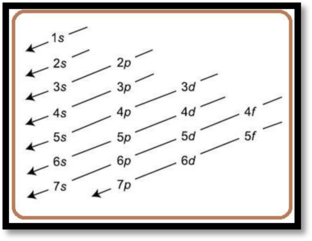
Concept explainers
(a)
Interpretation:
The given electron configuration
Concept Introduction:
Aufbau principle says that electron fills the lowest energy level before filling the higher ones.

Figure 1
(a)
Explanation of Solution
Given electron configuration is
The above electron configuration is wrong because the
The correct element and it electron configuration is
(b)
Interpretation:
The given electron configuration
Concept Introduction:
Refer to part (a).
(b)
Explanation of Solution
Given electron configuration is
The above electron configuration is right because the
The electron configuration is
The correct element and it electron configuration is
(c)
Interpretation:
The given electron configuration
Concept Introduction:
Refer to part (a).
(c)
Explanation of Solution
Given electron configuration is
The above electron configuration is wrong because two times
Hence, the correct element and it electron configuration is
(d)
Interpretation:
The given electron configuration
Concept Introduction:
Refer to part (a).
(d)
Explanation of Solution
Given electron configuration is
The above electron configuration is wrong as the
Hence, the correct element and it electron configuration is
Want to see more full solutions like this?
Chapter 2 Solutions
Connect 2-Year Online Access for General, Organic, and Biochemistry
 ChemistryChemistryISBN:9781305957404Author:Steven S. Zumdahl, Susan A. Zumdahl, Donald J. DeCostePublisher:Cengage Learning
ChemistryChemistryISBN:9781305957404Author:Steven S. Zumdahl, Susan A. Zumdahl, Donald J. DeCostePublisher:Cengage Learning ChemistryChemistryISBN:9781259911156Author:Raymond Chang Dr., Jason Overby ProfessorPublisher:McGraw-Hill Education
ChemistryChemistryISBN:9781259911156Author:Raymond Chang Dr., Jason Overby ProfessorPublisher:McGraw-Hill Education Principles of Instrumental AnalysisChemistryISBN:9781305577213Author:Douglas A. Skoog, F. James Holler, Stanley R. CrouchPublisher:Cengage Learning
Principles of Instrumental AnalysisChemistryISBN:9781305577213Author:Douglas A. Skoog, F. James Holler, Stanley R. CrouchPublisher:Cengage Learning Organic ChemistryChemistryISBN:9780078021558Author:Janice Gorzynski Smith Dr.Publisher:McGraw-Hill Education
Organic ChemistryChemistryISBN:9780078021558Author:Janice Gorzynski Smith Dr.Publisher:McGraw-Hill Education Chemistry: Principles and ReactionsChemistryISBN:9781305079373Author:William L. Masterton, Cecile N. HurleyPublisher:Cengage Learning
Chemistry: Principles and ReactionsChemistryISBN:9781305079373Author:William L. Masterton, Cecile N. HurleyPublisher:Cengage Learning Elementary Principles of Chemical Processes, Bind...ChemistryISBN:9781118431221Author:Richard M. Felder, Ronald W. Rousseau, Lisa G. BullardPublisher:WILEY
Elementary Principles of Chemical Processes, Bind...ChemistryISBN:9781118431221Author:Richard M. Felder, Ronald W. Rousseau, Lisa G. BullardPublisher:WILEY





